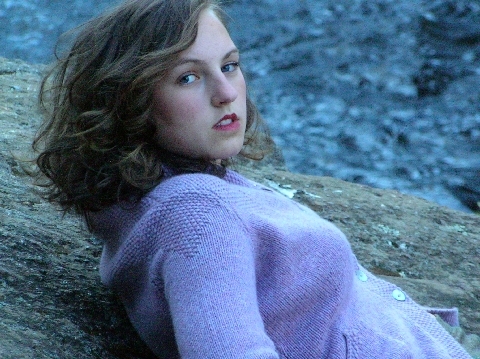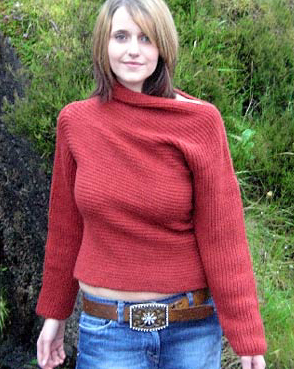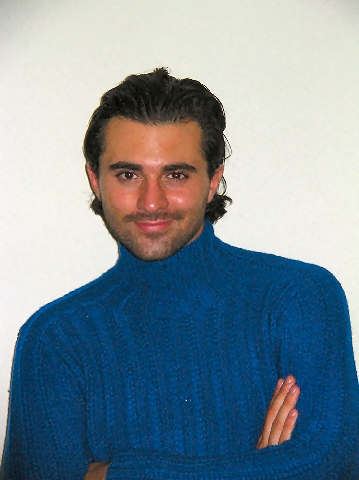Cashmere from
Scotland

The
country chiefly responsible for the commercial development of cashmere
yarn, i.e. Scotland, (Scotsman Joseph Dawson traveling in Kashmir in the
1870s developed a method to mechanize the separating of the fine goat
fiber from the course outer hair making the down suitable for spinning)
is rarely, if ever, credited in fashion magazines. Although we dread the
idea of sweater wearing when temperatures are in the 80’s, a brief rant
is in order.
 A
recent fashion magazine featured cashmere (or wool) sweaters on five (of
six) pages while the remaining page showed a tweed suit. With labels
from exclusive NY or Italian designers delicately sewn into them, all
decidedly plain affairs which appear to be machine knit (though we
haven’t called to double check) and universally come with price tags
that are not for the faint of heart. The collection of sweaters I refer
to ranged from $585 (USD) through
$1095 (USD)! Surely the name on the label can’t justify
that much for a machine knit sweater?
A
recent fashion magazine featured cashmere (or wool) sweaters on five (of
six) pages while the remaining page showed a tweed suit. With labels
from exclusive NY or Italian designers delicately sewn into them, all
decidedly plain affairs which appear to be machine knit (though we
haven’t called to double check) and universally come with price tags
that are not for the faint of heart. The collection of sweaters I refer
to ranged from $585 (USD) through
$1095 (USD)! Surely the name on the label can’t justify
that much for a machine knit sweater?
As
Scotsmen and women why should we even care? Indulge me. In the last
decade 35,000 jobs in the textile industry have been lost in Scotland.
With consolidation and declining skills, Scotland’s synonymous
association with cashmere knitwear would seem in real danger. What can
we do to stem this trend? Well, we can choose to make our purchases
close to home.
At
this time last year Thistle & Broom’s managing director saw a “Fair Isle
sweater in cashmere” in a fashion magazine priced at just over $900 (USD).
She confirmed her suspicions by calling the designer’s New York
headquarters; although it was hand knit the work was done in China and not in Fair Isle (or on any of the
Shetland Isles where Fair Isle patterns sweaters have been knit for
hundreds of years). She set about to channel her outrage, and set
things “to right”.
 As
recently as a third of a century ago the
Knoydart Peninsula, in the Western Highlands of Scotland, had no
telephone system (the closest phone box was 50 miles away). No public
water infrastructure or electricity grid existed and it was only
accessible by sea. Even today, according to the Guinness World Book of
Records, it is the most remote part of Great Britain. As a newly wed
Hillary Rohde took note that her new neighbours couldn't afford to buy
wool for new things and were constantly unpicking garments and endlessly
knitting anew. With a huge pool of talent to draw upon, she had a vision
of working with the best material available,
cashmere. When she began, no one made a yarn capable of being hand
knit, no shrinking violet Hillary approached one of the biggest cashmere
mills in Scotland, Todd & Duncan, and got what she wanted.
As
recently as a third of a century ago the
Knoydart Peninsula, in the Western Highlands of Scotland, had no
telephone system (the closest phone box was 50 miles away). No public
water infrastructure or electricity grid existed and it was only
accessible by sea. Even today, according to the Guinness World Book of
Records, it is the most remote part of Great Britain. As a newly wed
Hillary Rohde took note that her new neighbours couldn't afford to buy
wool for new things and were constantly unpicking garments and endlessly
knitting anew. With a huge pool of talent to draw upon, she had a vision
of working with the best material available,
cashmere. When she began, no one made a yarn capable of being hand
knit, no shrinking violet Hillary approached one of the biggest cashmere
mills in Scotland, Todd & Duncan, and got what she wanted.
Hillary Rohde spent over thirty years guiding hand-knit
cashmere to a level of extraordinary beauty,
(including providing the
hand knit efforts for such internationally recognisable labels as N.
Peal and Pringle of Scotland).
In the process the
company has created an international standard for excellence achieving
an almost a cult status for owning (and wearing regularly). Today over
three hundred hand knitters continue to produce extraordinary cashmere
knitwear, in turn there can be no doubt that together they are helping
to preserve cottage industry in Scotland much the way The
Harris Tweed Authority
has been able to do.
Working with
Hillary Rohde
Limited Thistle & Broom has developed an exclusive line of
entirely hand-knit cashmere* sweaters with names such as Off-Kilter,
sumair (Gaelic for the drone of a bag
pipe as the stitch clearly resembles), Gilgit (an ancient Kashmir city
noted for its location along the
Silk
Route traveled by Dawson and Waltz. Knit exclusively in
Kinross-based Todd & Duncan yarns, which is owned by the firm bearing
Joseph Dawson’s name, i.e., Dawson International, the unisex styles are
modeled by Pop Idol star Darius and his brother Aria while ladies styles
are variously represented on beautiful young Celtic women.
The
cashmere offered by Thistle & Broom is priced in the same range as those
previously mentioned sweaters, but there are three critical differences.
First, the hand knit quality is unequalled, second your purchase is
guaranteed to positively impact local economies across Scotland one
piece of knitwear at a time, and finally 8% of the net profits are
re-invested in Scottish cultural heritage and historic preservation.
Edinburgh-based Thistle & Broom got it just about right.
*As a
final point of useful information, it takes over 100 hours to knit a
single sweater and as you can imagine a considerable level of expertise
is demanded for working with such a fine fiber or in the complicated
patterns of traditional Fair Isle. Christmas orders much be received by
15 October to ensure delivery.
Links

